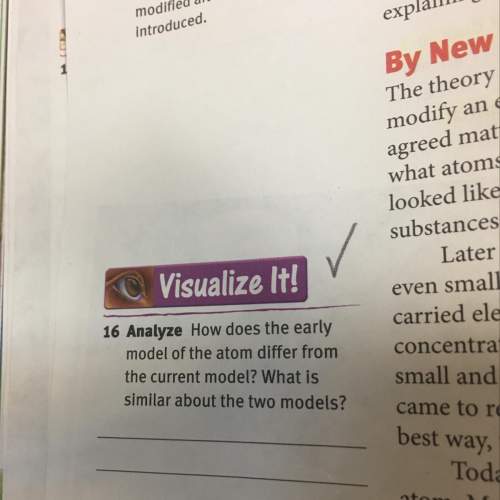
Chemistry, 17.04.2020 01:31 loistaylor1819
2. Suppose you placed two flasks, each filled with 100 milliliters of water, on a lab bench Then you covered one flask tightly with plastic wrap. After 3 days, how would the amount of water in the flasks compare ? Explain your answer

Answers: 1


Another question on Chemistry

Chemistry, 21.06.2019 23:30
Why do you suppose the structural polysaccharide cellulose does not contain branches? why do you suppose the structural polysaccharide cellulose does not contain branches? branches in the molecule would generate side chains that would almost certainly make it difficult to pack the cellulose molecules into globules, thereby decreasing the flexibility and strength of the globules. branches in the molecule would generate side chains that would almost certainly make it difficult to pack the cellulose molecules into microfibrils, thereby increasing the rigidity and strength of the microfibrils. branches in the molecule would generate side chains that would almost certainly make it difficult to pack the cellulose molecules into globules, thereby increasing the flexibility and strength of the globules. branches in the molecule would generate side chains that would almost certainly make it difficult to pack the cellulose molecules into microfibrils, thereby decreasing the rigidity and strength of the microfibrils.
Answers: 1

Chemistry, 22.06.2019 07:00
The organism shown is a free-living one that is anchored to the bottom of ponds and streams during one stage of its life cycle what is the common name for the group to which this organism belong
Answers: 3

Chemistry, 22.06.2019 11:40
Modern pennies are composed of zinc coated with copper. a student determines the mass of a penny to be 2.482 g and then makes several scratches in the copper coaling (to expose the underlying zinc). the student puts the scratched penny in hydrochloric acid, where the following reaction occurs between the zinc and the hcl (the copper remains undissolved): zn(s) + 2 hcl(aq) → h2(g) + zncl(aq)the student collects the hydrogen produced over water at 25 °c. the collected gas occupies a volume of 0.899 l at a total pressure of 79 j mmhg. calculate the percent zinc (by mass) in the penny. (assume that all the zn in the penny dissolves.)
Answers: 1

Chemistry, 22.06.2019 13:30
1) which of the following is the best example of a physical change? a) sugar dissolving in tea b) firefly glowing 2) in the combustion of ethane, what is/are the reactants? c2h6 + o2 ==> co2 + h2o a) c2h6 and o2 b) co2 and c2h6
Answers: 2
You know the right answer?
2. Suppose you placed two flasks, each filled with 100 milliliters of water, on a lab bench Then you...
Questions

English, 24.08.2019 05:50

History, 24.08.2019 05:50




Chemistry, 24.08.2019 05:50

World Languages, 24.08.2019 05:50

Mathematics, 24.08.2019 05:50

Social Studies, 24.08.2019 05:50

Mathematics, 24.08.2019 05:50

Mathematics, 24.08.2019 05:50

History, 24.08.2019 05:50

Social Studies, 24.08.2019 05:50





Mathematics, 24.08.2019 05:50

History, 24.08.2019 05:50

Mathematics, 24.08.2019 05:50




